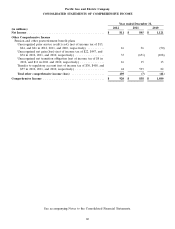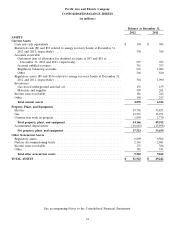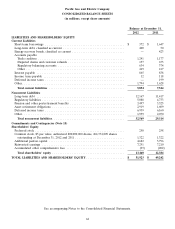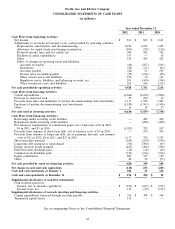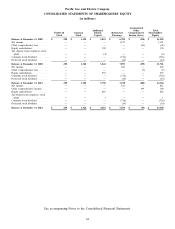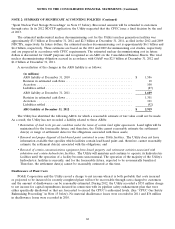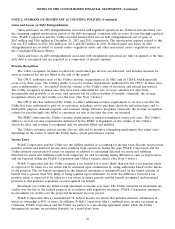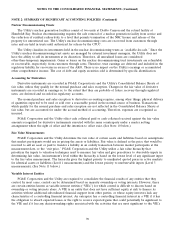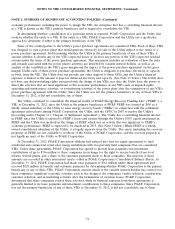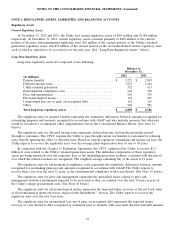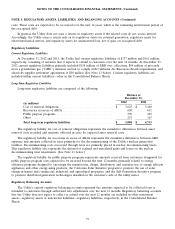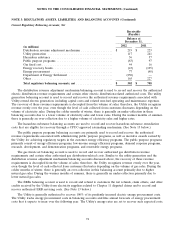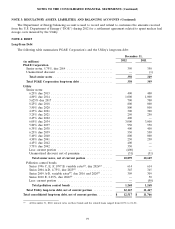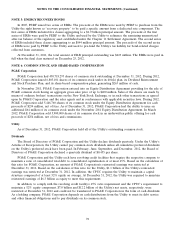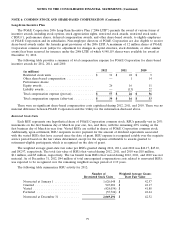PG&E 2012 Annual Report Download - page 73
Download and view the complete annual report
Please find page 73 of the 2012 PG&E annual report below. You can navigate through the pages in the report by either clicking on the pages listed below, or by using the keyword search tool below to find specific information within the annual report.NOTES TO THE CONSOLIDATED FINANCIAL STATEMENTS (Continued)
NOTE 2: SUMMARY OF SIGNIFICANT ACCOUNTING POLICIES (Continued)
Gains and Losses on Debt Extinguishments
Gains and losses on debt extinguishments associated with regulated operations are deferred and amortized over
the remaining original amortization period of the debt reacquired, consistent with recovery of costs through regulated
rates. PG&E Corporation and the Utility recorded unamortized loss on debt extinguishments, net of gain, of
$163 million and $186 million at December 31, 2012 and 2011, respectively. The amortization expense related to this
loss was $23 million in 2012, $18 million in 2011, and $23 million in 2010. Deferred gains and losses on debt
extinguishments are recorded to current assets—regulatory assets and other noncurrent assets—regulatory assets in
the Consolidated Balance Sheets.
Gains and losses on debt extinguishments associated with unregulated operations are fully recognized at the time
such debt is reacquired and are reported as a component of interest expense.
Revenue Recognition
The Utility recognizes revenues as electricity and natural gas services are delivered, and includes amounts for
services rendered but not yet billed at the end of the period.
The CPUC authorizes most of the Utility’s revenue requirements in its GRC and its GT&S, which generally
occur every three years. The Utility’s ability to recover revenue requirements authorized by the CPUC in these rates
cases is independent, or ‘‘decoupled’’ from the volume of the Utility’s sales of electricity and natural gas services.
The Utility recognizes revenues once they have been authorized for rate recovery, amounts are objectively
determinable and probable of recovery, and amounts will be collected within 24 months. Generally, the revenue
recognition criteria are met ratably over the year. (See Note 3 below.)
The CPUC also has authorized the Utility to collect additional revenue requirements to recover costs that the
Utility has been authorized to pass on to customers, including costs to purchase electricity and natural gas; and to
fund public purpose, demand response, and customer energy efficiency programs. Generally, the revenue recognition
criteria for pass-through costs billed to customers are met at the time the costs are incurred.
The FERC authorizes the Utility’s revenue requirements in annual transmission owner rate cases. The Utility’s
ability to recover revenue requirements authorized by the FERC is dependent on the volume of the Utility’s
electricity sales, and revenue is recognized only for amounts billed and unbilled.
The Utility’s revenues and net income also are affected by incentive ratemaking mechanisms that adjust rates
depending on the extent to which the Utility meets certain performance criteria.
Income Taxes
PG&E Corporation and the Utility use the liability method of accounting for income taxes. Income tax provision
includes current and deferred income taxes resulting from operations during the year. PG&E Corporation and the
Utility estimate current period actual tax expense in addition to calculating deferred tax assets and liabilities.
Deferred tax assets and liabilities result from temporary tax and accounting timing differences, such as depreciation,
and are reported within the PG&E Corporation and Utility’s balance sheets. (See Note 9 below.)
PG&E Corporation and the Utility recognize a tax benefit if it is more likely than not that a tax position taken
or expected to be taken in a tax return will be sustained upon examination by taxing authorities based on the merits
of the position. The tax benefit recognized in the financial statements is measured based on the largest amount of
benefit that is greater than 50% likely of being realized upon settlement. As such, the difference between a tax
position taken or expected to be taken in a tax return in future periods and the benefit recognized and measured
pursuant to this guidance represents an unrecognized tax benefit.
Investment tax credits are deferred and amortized to income over time. The Utility amortizes its investment tax
credits over the life of the related property in accordance with regulatory treatment. PG&E Corporation amortizes
its investment tax credits over the projected investment recovery period.
PG&E Corporation files a consolidated U.S. federal income tax return that includes domestic subsidiaries in
which its ownership is 80% or more. In addition, PG&E Corporation files a combined state income tax return in
California. PG&E Corporation and the Utility are parties to a tax-sharing agreement under which the Utility
determines its income tax provision (benefit) on a stand-alone basis.
69



